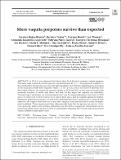Files in this item
More vaquita porpoises survive than expected
Item metadata
| dc.contributor.author | Rojas-Bracho, Lorenzo | |
| dc.contributor.author | Taylor, Barbara | |
| dc.contributor.author | Booth, Cormac Graham | |
| dc.contributor.author | Thomas, Len | |
| dc.contributor.author | Jaramillo-Legorreta, Armando | |
| dc.contributor.author | Nieto-García, Edwyna | |
| dc.contributor.author | Cárdenas Hinojosa, Gustavo | |
| dc.contributor.author | Barlow, Jay | |
| dc.contributor.author | Mesnick, Sarah L. | |
| dc.contributor.author | Gerrodette, Tom | |
| dc.contributor.author | Olson, Paula | |
| dc.contributor.author | Henry, Annette | |
| dc.contributor.author | Rizo, Henoch | |
| dc.contributor.author | Hidalgo-Pla, Eva | |
| dc.contributor.author | Bonilla-Garzón, Andrea | |
| dc.date.accessioned | 2022-08-03T11:30:03Z | |
| dc.date.available | 2022-08-03T11:30:03Z | |
| dc.date.issued | 2022-07-28 | |
| dc.identifier | 280706159 | |
| dc.identifier | 386b1ebd-96e1-4675-b217-e79fe2936057 | |
| dc.identifier | 85135511579 | |
| dc.identifier | 000852789700006 | |
| dc.identifier.citation | Rojas-Bracho , L , Taylor , B , Booth , C G , Thomas , L , Jaramillo-Legorreta , A , Nieto-García , E , Cárdenas Hinojosa , G , Barlow , J , Mesnick , S L , Gerrodette , T , Olson , P , Henry , A , Rizo , H , Hidalgo-Pla , E & Bonilla-Garzón , A 2022 , ' More vaquita porpoises survive than expected ' , Endangered Species Research , vol. 48 , pp. 225-234 . https://doi.org/10.3354/esr01197 | en |
| dc.identifier.issn | 1863-5407 | |
| dc.identifier.other | crossref: 10.3354/esr01197 | |
| dc.identifier.other | ORCID: /0000-0002-7436-067X/work/116910241 | |
| dc.identifier.uri | https://hdl.handle.net/10023/25767 | |
| dc.description | We thank SMRU Consulting and the University of St. Andrews for supporting C.B. and L.T.’s time, respectively. | en |
| dc.description.abstract | In 2018, it was estimated that fewer than 20 of Mexico’s endemic vaquita porpoise Phocoena sinus remained, and the species was declining by 47% yr-1. Entanglement in gillnets is the sole threat to the species, and since the last population size estimate, gillnetting has increased in the small area where most vaquitas remain—a 12 × 24 km area in the Gulf of California near San Felipe, Mexico. We conducted research efforts in 2019 and 2021 in that area to estimate the minimum numbers of adults and calves and look for any signs that vaquitas are unhealthy. Through expert elicitation, we estimated between 7 and 15 unique individuals were seen in 2019 and 5-13 were seen in 2021. Calves were seen in both years, and all vaquitas appeared healthy. Population projections from the last full survey indicated that more vaquitas have survived than expected. We suggest that these surviving adult vaquitas may have learned to avoid entanglement in gillnets. These vaquitas and their calves provide hope that the species can survive. However, given the high levels of illegal gillnetting and the theft of equipment which hindered our monitoring efforts, and with only around 10 individuals remaining, survival can only be assured if vaquita habitat is made gillnet-free. | |
| dc.format.extent | 10 | |
| dc.format.extent | 532082 | |
| dc.language.iso | eng | |
| dc.relation.ispartof | Endangered Species Research | en |
| dc.subject | Phocoena sinus | en |
| dc.subject | Vaquita | en |
| dc.subject | Conservation | en |
| dc.subject | Endangered species | en |
| dc.subject | Behavioral selection | en |
| dc.subject | Monitoring small populations | en |
| dc.subject | Expert elicitation | en |
| dc.subject | Illegal fishing | en |
| dc.subject | Porpoise | en |
| dc.subject | GC Oceanography | en |
| dc.subject | QH301 Biology | en |
| dc.subject | 3rd-DAS | en |
| dc.subject.lcc | GC | en |
| dc.subject.lcc | QH301 | en |
| dc.title | More vaquita porpoises survive than expected | en |
| dc.type | Journal article | en |
| dc.contributor.institution | University of St Andrews. Statistics | en |
| dc.contributor.institution | University of St Andrews. Marine Alliance for Science & Technology Scotland | en |
| dc.contributor.institution | University of St Andrews. Centre for Research into Ecological & Environmental Modelling | en |
| dc.contributor.institution | University of St Andrews. SMRU Consulting | en |
| dc.identifier.doi | https://doi.org/10.3354/esr01197 | |
| dc.description.status | Peer reviewed | en |
This item appears in the following Collection(s)
Items in the St Andrews Research Repository are protected by copyright, with all rights reserved, unless otherwise indicated.

